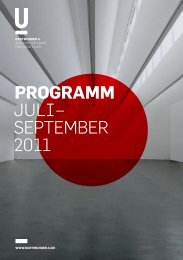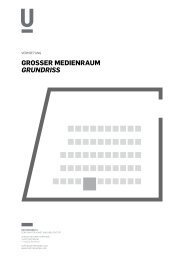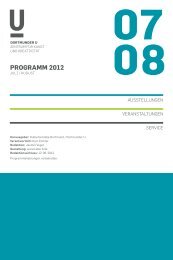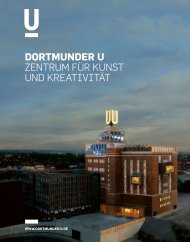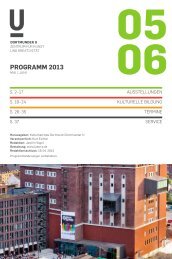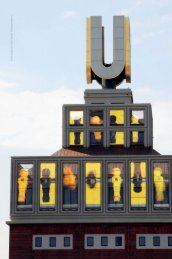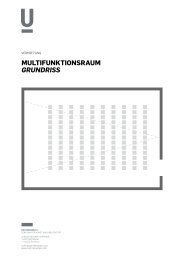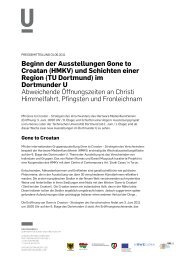dortmunder u CENTRE FOR ART AND CREATIVITY
dortmunder u CENTRE FOR ART AND CREATIVITY
dortmunder u CENTRE FOR ART AND CREATIVITY
You also want an ePaper? Increase the reach of your titles
YUMPU automatically turns print PDFs into web optimized ePapers that Google loves.
6<br />
THE DORTMUNDER U –<br />
AN <strong>ART</strong> <strong>AND</strong> CULTURE <strong>CENTRE</strong><br />
<strong>FOR</strong> THE 21ST CENTURY<br />
Dr. Andreas Broeckmann<br />
FOUNDING DIRECTOR<br />
Top: Exhibition E-Culture Fair 2010,<br />
Interactive Urban Projection, MediaLAB,<br />
Hogeschool van Amsterdam,<br />
Photo: © Hans Jürgen Landes<br />
Centre: Exhibition TRUST during<br />
ISEA2010 RUHR, Seiko Mikami, Desire<br />
of Code, Photo: © Hans Jürgen Landes<br />
Bottom: Exhibition TRUST during<br />
ISEA2010 RUHR, Opening performance,<br />
Antoine Chessex and Thomas<br />
Ankersmit, Diffusions / Acoustics,<br />
Photo: © Mark Ansorg<br />
During the European Capital of Culture RUHR.2010<br />
the “Dortmunder U – Centre for Art and Creativity”<br />
is being established in the former fermenting and<br />
storage tower of the Dortmunder Union Brewery,<br />
which was built in 1926/27 and is now protected as<br />
a historical monument. From now on a continuous<br />
stream of events, exhibitions and diverse cultural<br />
happenings, involving a unique mix of art, research,<br />
cultural education and creative business, will be<br />
available here to a wide public, whose participation in<br />
the events is especially valued. The Centre is based<br />
on a collaboration between the various users of the<br />
Dortmunder U building: the Museum Ostwall, the<br />
Hartware MedienKunstVerein, the Cultural Office<br />
of the City of Dortmund, the Dortmund University of<br />
Applied Sciences and Arts, the TU Dortmund University,<br />
the european centre for the creative economy<br />
(ecce) and the U Cinema association, operating the<br />
RWE Forum. The Centre is situated in Dortmund, in<br />
the Ruhr Metropolis and in North Rhine-Westphalia<br />
but also has international ambitions and partici -<br />
pates in both regional and international projects.<br />
The building was erected in 1926/27 to a design<br />
drawn up by the architect Emil Moog and was immediately<br />
one of the most imposing buildings in the Ruhr.<br />
It embodied the Dortmunder Union’s importance<br />
as one of the leading breweries in Europe as well as<br />
the equal status that brewing held in Dortmund at<br />
that time, alongside the coal and steel industries.<br />
The four-sided “U” was designed by Ernst Neufert<br />
and added to the tower’s roof in 1968 and has been<br />
an emblem of the city ever since, greeting those<br />
travelling to Dortmund from afar, and providing<br />
a landmark for the city’s night-owls.<br />
Today, after the conversion and renovation by Gerber<br />
Architects, the Dortmunder U is a symbol, for the<br />
city and for the whole Ruhr Metropolis, of new<br />
departures and of the Ruhr’s structural change from<br />
heavy industry to a region in which research and<br />
science, creativity and culture are the most important<br />
resources.<br />
The constellation of the partners and the connections<br />
between their respective work and projects<br />
will shape the aims and objectives of the new<br />
Dortmunder U. Since it was founded after World War<br />
II, the Museum Ostwall has stood for a committed<br />
and enlightened approach to the art of the 20th and<br />
21st centuries, seeing art and aesthetic practice as<br />
central to society and to the life of each individual.<br />
For 15 years, the Hartware MedienKunstVerein has,<br />
with its exhibitions, symposia and workshops, been<br />
promoting and presenting artistic debate around<br />
the current role of media and technologies. As early<br />
as 1998, Hartware proved with its pioneering exhibition<br />
Zones of Desire that the Dortmunder U made<br />
an outstanding setting for the presentation of contemporary<br />
art.<br />
The TU Dortmund University brings specialist competence<br />
to the mix, not only in the fields of art and<br />
didactics but also with expertise from faculties such<br />
as Economics or Urban and Spatial Planning, which<br />
will strengthen the work and discussions going on in<br />
the U. The Dortmund University of Applied Sciences<br />
and Arts will contribute to the U’s programme not<br />
only with its creative results from research and<br />
teaching in its specialist area of design, but also with<br />
a planned Research Institute for the Study of Moving<br />
Images. The latter will take as its starting point<br />
Prof. Adolf Winkelmann’s film installations for the U<br />
and will develop the practical and scientific-theoretical<br />
analysis of digital images and media façades. In<br />
the multifunctional events space of the RWE Forum,<br />
the U Cinema association offers an ambitious film<br />
programme, which is being initiated by the International<br />
Women’s Film Festival Dortmund | Cologne<br />
and which will reinforce the collaborative work between<br />
the various U partners by linking in to the projects<br />
and programmes of the other institutions. The<br />
european centre for creative economy – ecce, that<br />
has already organized the creative economy work of<br />
RUHR.2010 Ltd, is an U partner, whose main task is<br />
connecting regional and national partners, networks<br />
and skills. Finally, the Cultural Office of the City of<br />
Dortmund is setting up a new Centre for Cultural<br />
Education in the U and will bring its years of experience<br />
in connecting people and networking to the mix.<br />
The example of cultural education demonstrates that<br />
none of the partner institutions has a one-dimensional<br />
fixation with only one of the U’s four programmatic<br />
pillars (art, creativity, education, research). All<br />
partners are already active in cultural education and<br />
will be able to consolidate, coordinate and strengthen<br />
their activities with the new cooperative work,<br />
housed under one roof. The same is true of the other<br />
programmatic pillars, which will also be developed<br />
in the shared spaces on the floor for temporary



